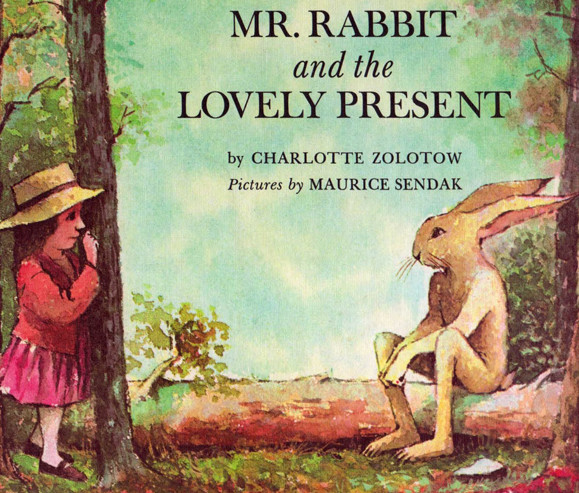
by DonnaGibbs | Jun 14, 2016 | Books and Children
Children’s learning patterns can seem quite mysterious to an adult. The meanings they take from stories, for example, can be different from the meanings we think they take. In an earlier post I described how children need quite some time to work out what is real and what isn’t; and to come to understand the conventions of form and illustration in picture books – all processes which affect how they construct meaning.
Here are some further things to note:
A child’s logic may not seem logical to an adult. For example: A child might ask the following slightly off-track questions during a reading of The Three Little Pigs:
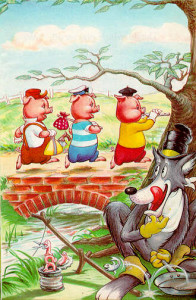
The Three Little Pigs
Why don’t animals eat themselves?
Why don’t wolves blow people’s houses down?
Do pigs wear hats?
Can pigs walk?
The adult sees these questions as irrelevant to the story being read. But the child has to work through many different connections between ideas and how things work in the world before they come to a similar kind of understanding. Their ‘own’ logic is very precious because it is based on seeing the world through new eyes.
What should you do? Should you interrupt your reading so that the thread of the story is lost and try to answer the questions asked as best you can? I think so. If the child’s mind is actively seeking answers then they really need to know what those answers are.
Of course, some children get so caught up with the questions that you never get back to the story. Maybe if this happens you can suggest you have a turn of just listening to the story. But on the whole questions shouldn’t be discouraged – it means the child is learning to think independently.
Children do not have an automatic understanding of idioms, homonyms and word play. Language has many encoded mysteries which adults understand without consciously thinking about them.
For example, a simple word can cause confusion to a child because it has more than one meaning. I recall the word ‘feet’ causing this problem for my daughter when we were reading Winnie-the-Pooh: ‘Oh, help!’ said Pooh, as he dropped ten feet to the branch below him.’
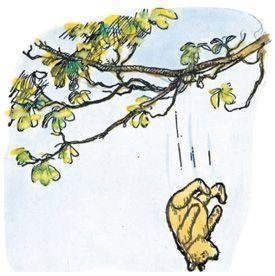
From Winnie-the-Pooh
But in the picture, as Juliet pointed out, Pooh only drops two feet, not ten! She was convinced the author had got it wrong. This kind of confusion is also caused with idioms.
What should you do? It is probably better to talk about these concepts outside of reading time. You could play word games to help this kind of understanding. Then when they do cause confusion in a reading it will be easier to explain what is meant.
Progress in a child’s learning is not continuously forward and may seem to get ‘stuck’ at times. A common learning pattern for a child is to take a step forward, then a step backward, pause there for a time, then move forward again.
Sometimes, a story a child seemed to understand suddenly raises questions from them suggesting they’ve missed the point entirely. There can be many reasons for this but one is that they become temporarily obsessed with something – not necessarily for reasons we understand. Subjects that regularly come under children’s scrutiny in this way include hands; feet; fathers; mothers; who/what looks after who/what; stealing; eating animals; death; and what’s real or pretend. A child will endlessly test out what can be known about their current fascination – they relate it to everything else – both successfully and unsuccessfully, they imitate it, and they see connections that may or may not be there.
What should you do? Understanding that there are common, seemingly irregular, learning patterns that most children work through means there’s no need to feel anxious when a child seems to ‘go backwards’. It is a part of their learning even though it looks as if it’s the opposite!
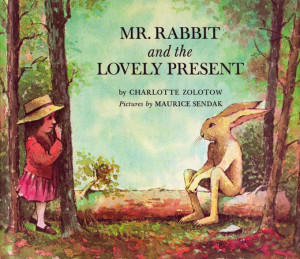
Mr Rabbit and the Lovely Present
Children build on what they know of the world by relating it to their books and their books gain in meanings as they learn more about the world.
This is a reciprocal process which reinforces understanding of a whole range of things. In other words, the books you read to children aren’t only offering them the pleasure of story and enrichment for the imagination. They also help build and consolidate ways of understanding and knowing.
What should you do? You can look out for books that might be helpful for situations relevant to your child. There is almost certainly a book that explores every new situation a child will face such as their ‘first time’ experiences – the dentist, the doctor, kindergarten, school – the death of a pet, the birth of a baby brother or sister and so on. It is best though to try to choose well written books that achieve their purpose in imaginative ways as books of this kind can be of poor quality. Do you have any recommendations?
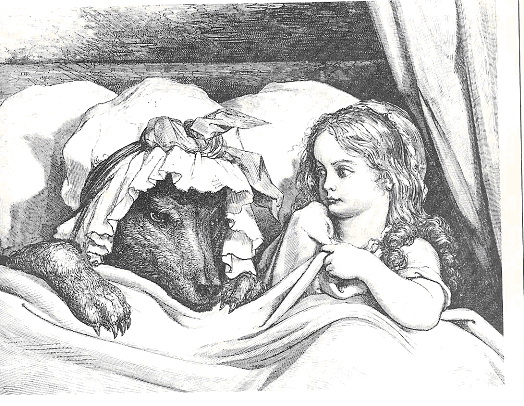
by DonnaGibbs | Mar 9, 2016 | Books and Children
Does it matter which version of a classic story you read to your child? Well – yes and no. You can be fairly sure the time tested magic of these tales, as long as age appropriate, will probably spread their enchantment, whichever the version. But there is more to it.
What started me thinking about this was some additional suggestions for popular books for two and a half year olds that came my way after my last post:
The Gingerbread Man
The Three Billy Goats Gruff
The Three Bears
Little Red Riding Hood
These classics, mostly originating as oral tales, come in many written versions. Different story tellers have told and illustrated the tales in different ways over time. Did you know that Goldilocks, for example, was originally a fox, not a girl, in earlier versions of the story? If you want to learn more about changes in these tales, dip into Iona and Peter Opie’s book, The Classic Fairy Tales. It is a fascinating study.
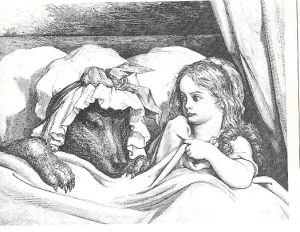
Dore’s illustration of Red Riding Hood, 1872, from the Opie’s Classic Fairy Tales.
Modern retellings of classic tales with a wide range of illustration styles continue to be produced. Call up Google images and type in a title or a character’s name to see what I mean.
Each version of a classic tale, through its choice of words and style of illustration, tells a different story. Some wordings are so beautifully crafted that you find yourself slipping into the forest with the characters, pausing there wide-eyed in delicious fear, making judgements and weighing up the possibilities. Other writers tell their stories more prosaically leaving a reader’s senses and empathies unengaged.
It is not only the words of the stories that carry values, create a moral world and play with stereotypes. For example, if Goldilocks lives up to her name and is pictured as the traditionally beautiful golden long-haired girl (as she is in the illustration below), then she is somehow made into a virtuous heroine with right on her side – even though she is the one to break into the three bear’s cottage and steal their food!

From Raphael Tuck’s ‘Combined Expanding Toy and Painting book series.’ c 1900
If, on the other hand, she is pictured as a dumpy, curly haired miss, with very poor dress sense, the story changes. The bears wouldn’t stand a chance against her! You can imagine this Goldilocks giving the door a good bang or even a kick, and shouting loudly, ‘Is anyone there? I’m hungry.’ Same story, but very different messages being sent through the illustrations.
So, is it ok to stick with a Disney version of one of these famous tales. Probably not. Children deserve to hear well written, well illustrated, age appropriate versions of classic tales. I wouldn’t avoid a Disney version but reading different versions at different times seems to me a good option. After all, children must to learn to discriminate for themselves. And it’s good for children to learn there are different ways of telling – a vital understanding that takes time to absorb and a concept on which many other concepts depend.
In my experience, children listening to classic tales become quite still and quiet. There is a special quality to their silence. You can actually see the magic of the story take hold. Have you found this? Are there any versions of classic tales you would recommend?

A different kind of Goldilocks.
* * * * * * * * *
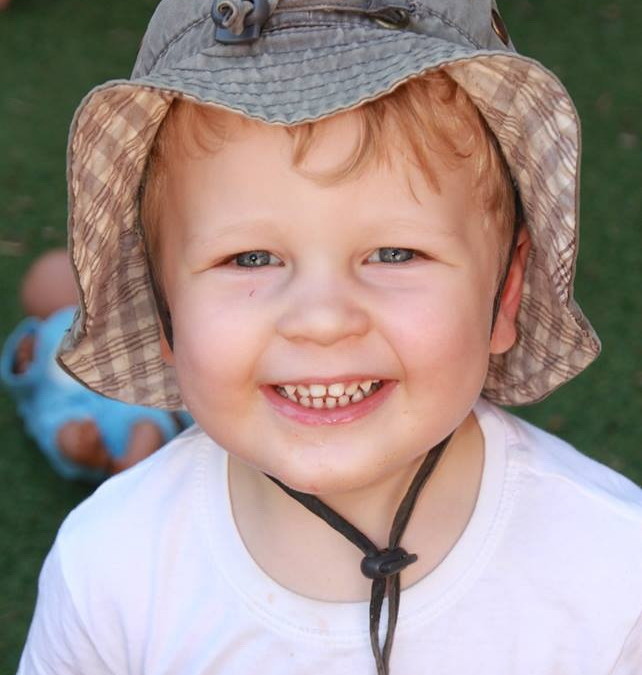
by DonnaGibbs | Feb 25, 2016 | Books and Children
I was asked this week if I could recommend a book for a two and a half year old Canadian boy with a Dutch mum and Afrikaans dad.
I decided to ask my little friend, Quinn, who is about the right age, which are his favourite books. With the help of his mum, Quinn listed his top four.
1 Where is the green sheep, Judy Horacek and Mem Fox. (These authors have a new book out too that looks appealing– This and That. )
2 The Tiger who came to tea, Judith Kerr.
3 We are going on a bear hunt, Michael Rosen.
4 Dig Dig digging, Margaret Mayo and Alex Ayliffe.
I think the children in my Kindy group, where I read as a volunteer, would agree with Quinn’s choices. They also like:
5 The Terrible Plop, Ursula Dubosarsky and illos by Andrew Joyner
6 The very hungry caterpillar, Eric Carle
7 The Grufallo, Julia Donaldson and Axel Scheffler, and
8 Guess how much I love you, Sam McBratney
9 The cat in the hat Dr Seuss, and
10 The Hairy Mclary books, Lynley Dodd?
Do you have any suggestions?
A few observations
The books children most enjoy are not necessarily the books adults would choose for them. For example, I disliked Where is the green sheep when I first read it. Yet, like Quinn, children just love this book. It is probably better to choose books that are popular with children rather than to follow our own tastes (well, sometimes anyway).
- The books children most enjoy are not necessarily the books adults would choose for them. For example, I disliked Where is the green sheep when I first read it. Yet, like Quinn, children just love this book. It is probably better to choose books that are popular with children rather than to follow our own tastes (well, sometimes anyway).
- Repetition, rhyme, refrains and a catchy rhythm (evident in most of these choices) are a sure fire success. This age group loves to join in a refrain, anticipate words, make noises and generally be rowdy and involved. Books with these elements have strong links with the nursery rhymes that many children know and love from a very young age.
- An element of fear (along as the danger is overcome) is another favourite ingredient. Children love a story that reveals increasing danger –you see it in their body language and the expressions on their faces!
- No single illustration style is a winner. Big and brightly coloured works well but so do many other styles. It is more to do with how the illustration works with the story.
I noticed that there are YouTube and other electronic readings of most of these books available online such as Michael Rosen’s telling of his We are going on a bear hunt (See https://www.youtube.com/watch?v=0gyI6ykDwds). But, generally speaking, the online versions offer an inferior experience to that of reading the book. Have you come across any worth knowing about? Or do you avoid them?
So – I haven’t really answered the question I was asked. But I have tried to suggest what to look out for when you are in a library or a bookshop trying to choose a book for a two and a half year old. And that’s half the fun, of course!










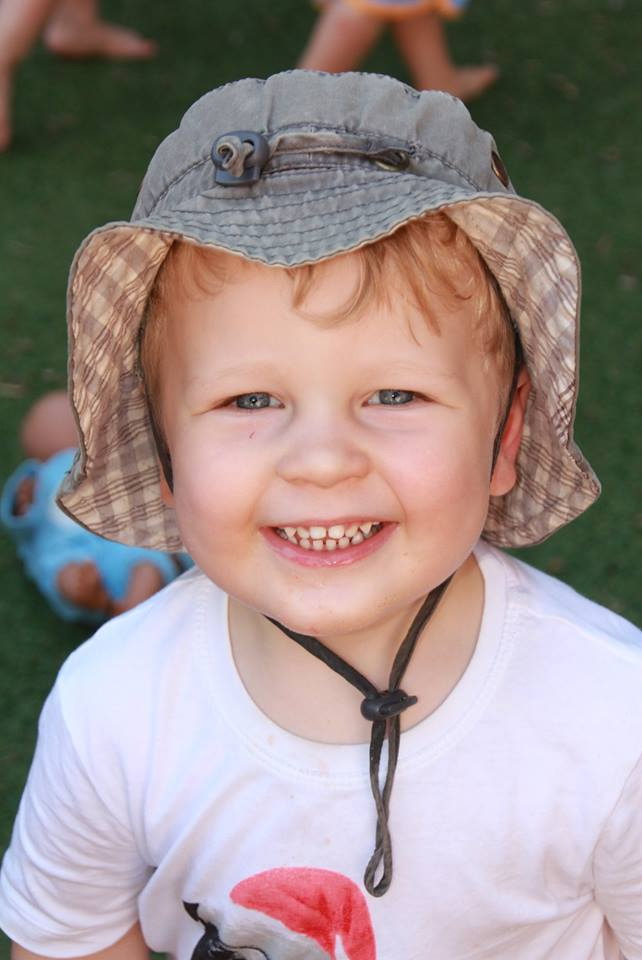
Recent Comments